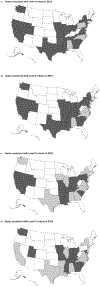Seven years later: state neonatal risk-appropriate care policy consistency with the 2012 American Academy of Pediatrics Policy
- PMID: 34253843
- PMCID: PMC9198846
- DOI: 10.1038/s41372-021-01146-y
Seven years later: state neonatal risk-appropriate care policy consistency with the 2012 American Academy of Pediatrics Policy
Abstract
Objective: To assess consistency of state neonatal risk-appropriate care policies with the 2012 AAP policy seven years post-publication.
Study design: Systematic, web-based review of all publicly available 2019 state neonatal levels of care policies. Information on infant risk (gestational age, birth weight), technology and equipment capabilities, and availability of specialty staffing used to define neonatal levels of care was extracted for review.
Result: Half of states (50%) had a neonatal risk-appropriate care policy. Of those states, 88% had language consistent with AAP-defined Level I criteria, 80% with Level II, 56% with Level III, and 55% with Level IV. Comparing policies (2014-2019), consistency increased in state policies among all levels of care with the greatest increase among level IV criteria.
Conclusion: States improved consistency of policy language by each level of care, though half of states still lack policy to provide minimum standards of care to the most vulnerable infants.
© 2021. This is a U.S. government work and not under copyright protection in the U.S.; foreign copyright protection may apply.
Conflict of interest statement
COMPETING INTERESTS
The authors declare no competing interests.
Figures

References
-
- American Academy of Pediatrics. Policy statement: levels of neonatal care. Pediatrics 2012;130:587–97. - PubMed
-
- March of Dimes. Toward improving the outcome of pregnancy: recommendations for the Regional Development of Maternal and Perinatal Health Services. White Plains, NY: March of Dimes; 1976.
-
- March of Dimes. Toward improving the outcome of pregnancy: the 90s and beyond. White Plains, NY: March of Dimes; 1993.
-
- March of Dimes. Toward improving the outcome of pregnancy: enhancing perinatal health through quality, safety, and performance initiatives. White Plains, NY: March of Dimes; 2011.
-
- American Academy of Pediatrics. AAP publications reaffirmed or retired. Pediatrics 2015;136:e1418.
MeSH terms
Grants and funding
LinkOut - more resources
Full Text Sources
Medical
Miscellaneous

